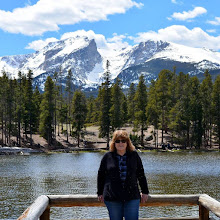Every year, I tenderly take out of bubble wrap this Nativity set that I purchased the first Christmas of our marriage, 51 years ago! The three angels on the right in the stable wind up over a music box and play the song "Silent Night."
The month of December is a whirlwind! Between shopping, decorating, holiday plans, buying and wrapping presents, attending grandchildren's events at school, and holiday get-togethers and parties, it seems as if the month goes by so quickly! But what really matters this month as Christians is that we remember the "Reason for the Season," which is that December's Christmas Day is a celebration of the birth of Jesus.
A few years ago, my husband and I went with a few friends to a concert at the Lakewood Cultural Center in Lakewood, Colorado, to attend the annual Timothy P Irvin and the Rocky Mountain Stocking Stuffers Concert. All the musicians and singers were very talented, as they sang a combination of Western country and bluegrass Christmas songs. One very remarkable rendition of Silent Night was sung by Jon Chandler. He told us that when he was growing up, his grandparents and great-grandmother lived with his family. His great-grandmother told him as a child that her great-grandfather was Franz Gruber, the composer who wrote the guitar music to the song Silent Night. He then went on to perform the song so beautifully!
I found the video above, on YouTube, of him telling the story and singing the song at a different venue. Click here to go to YouTube if you can not see the video. There are so many beautiful renditions of Silent Night, but I think you will also enjoy hearing Jon sing it in English and native German.
Some of the Nativity Christmas ornaments that decorate my Christmas tree.
See my entire Christmas tree in this post
Year after year, the Denver City and County Building is beautifully lit for the Christmas season, and it features a Nativity scene in a display in front.
The beautiful, life-size Nativity set that I loved to see every year in my church when I lived in Brooklyn, New York.
Some of the many other Nativity sets I've admired over the years.
"At this Christmas, when Christ comes, will He find a warm heart? Mark the season of Advent by loving and serving others
with God's own love and concern."
~ Mother Teresa
A beautiful sunset this week over our neighborhood.
"The Blessings of Peace,
The beauty of Hope,
The Spirit of Love,
The Comfort of Faith.
May these be your gifts
this Christmas Season!"
Have a very Merry Christmas and a Happy and Healthy 2026!
Blogs I link with:
Nature Notes, Home Matters Linky Party, Ducks in a Row, Monday Morning Blog Club, Good Random Fun, Talk About It Tuesday, The Happy Now Tuesday, Wordless Wednesday, Wordless Wednesday 2, Wednesday My Corner of the World, Wonderful Wednesday, Thankful Thursday, Little Things Thursday, Thursday Favorite Things, Skywatch Friday, Fantastic Friday, Farmhouse Friday, Crazy Little Lovebirds Friday Link Up, Dare to Share, Saturday Sparks, Saturday Critters,















-COLLAGE.jpg)























